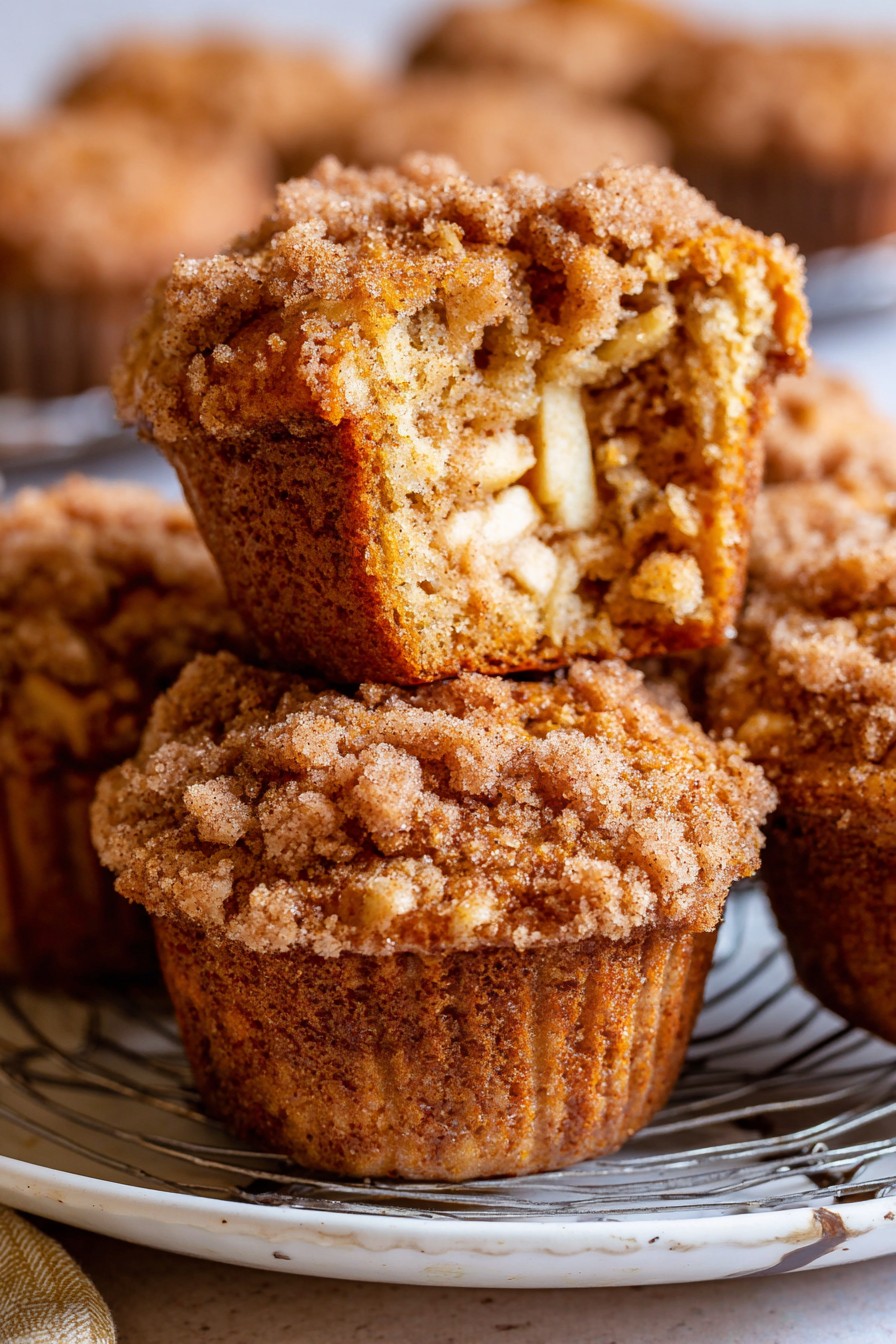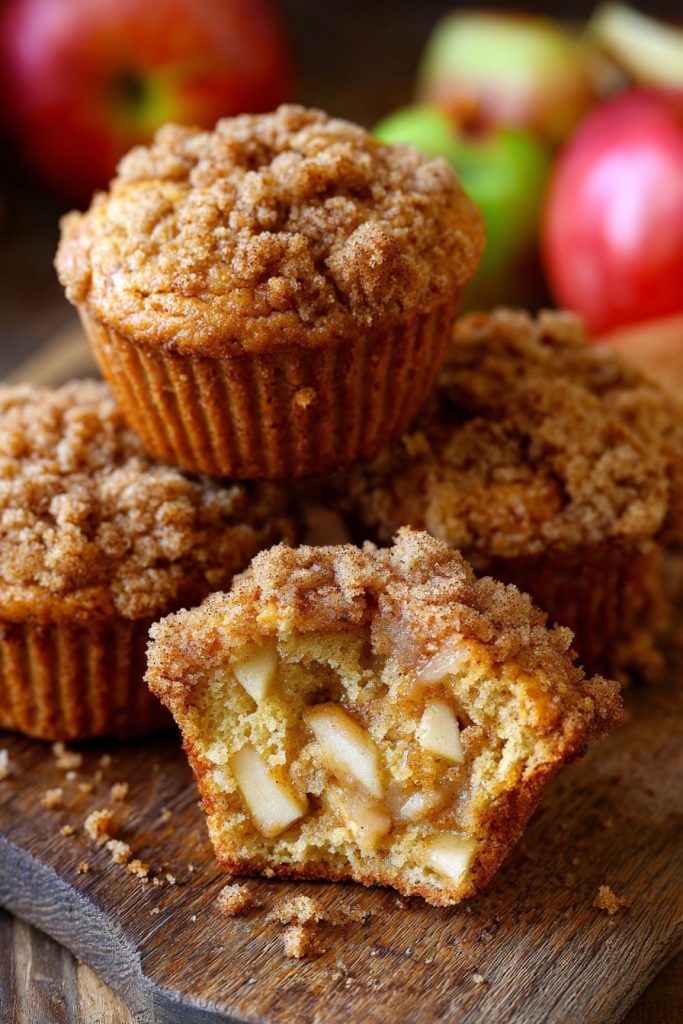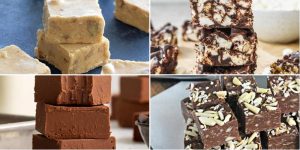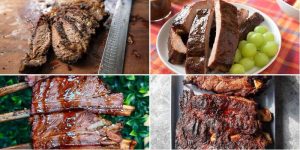Aromatic spices waft through kitchens from New England to Normandy when apples meet cinnamon, and these apple crumb muffins capture that universal autumn magic. Across continents, the humble muffin transforms into portable comfort, while the crumb topping echoes German streusel traditions and British crumble desserts. Each bite carries whispers of orchard visits and cozy cafes where such treats bridge cultures through shared culinary joy.
Why This Recipe Works
- The triple-apple approach—fresh diced apples, apple butter, and apple cider reduction—creates layered fruit flavor that European bakers would admire, ensuring moistness without sogginess through precise moisture balancing learned from French patisserie techniques.
- Cold butter chunks in the crumb topping mimic Dutch and Scandinavian baking methods, creating craggy, crisp texture contrasts that elevate the soft muffin base, much like the streusel-topped kuchen found in Viennese coffee houses.
- Buttermilk’s tangy complexity, cherished in Southern American baking, tenderizes the crumb while balancing the sweetness, a technique also seen in Irish soda breads where acidity activates baking soda for perfect rise.
- Warm spice blending—cinnamon, nutmeg, cardamom—follows Middle Eastern and North African traditions where spice markets inspire balanced heat and sweetness, creating aromatic depth beyond typical cinnamon-apple pairings.
- The muffin method (dry and wet ingredients mixed separately) honors classic American baking science while the steam-releasing apple dice distribution ensures even baking, a technique perfected in English muffin pudding adaptations.
Ingredients
- 2 cups all-purpose flour
- 1 teaspoon baking soda
- 1 teaspoon baking powder
- ½ teaspoon salt
- 2 teaspoons ground cinnamon
- ¼ teaspoon ground nutmeg
- ⅛ teaspoon ground cardamom
- ½ cup unsalted butter, softened
- ¾ cup granulated sugar
- ½ cup light brown sugar, packed
- 2 large eggs, room temperature
- 1 teaspoon vanilla extract
- ½ cup buttermilk, room temperature
- ⅓ cup apple butter
- 1 ½ cups peeled and finely diced apples (about 2 medium apples)
- ¼ cup apple cider, reduced to 2 tablespoons
Crumb Topping
- ¾ cup all-purpose flour
- ⅓ cup light brown sugar, packed
- ¼ cup granulated sugar
- 1 teaspoon ground cinnamon
- 6 tablespoons cold unsalted butter, cubed
Equipment Needed
- Standard 12-cup muffin tin
- Muffin liners or parchment paper squares
- Large and medium mixing bowls
- Whisk and rubber spatula
- Measuring cups and spoons
- Pastry cutter or fork (for crumb topping)
- Ice cream scoop (for even batter distribution)
- Wire cooling rack
- Small saucepan (for cider reduction)
Instructions

Prepare Your Ingredients and Crumb Topping
Begin by reducing the apple cider in a small saucepan over medium heat, watching as bubbles form at the edges and the liquid thickens to a syrupy consistency—this should take about 5-7 minutes until reduced by half. Meanwhile, whisk together the crumb topping ingredients except butter in a medium bowl, then work in the cold butter cubes using a pastry cutter or fork until pea-sized crumbs form. The key here is keeping everything cold, much like Scandinavian bakers do when creating their famous crumb cakes. Refrigerate this mixture while preparing the batter. Peel and dice your apples into ¼-inch pieces, tossing them with a tablespoon of the measured flour to prevent sinking—a technique borrowed from British steamed pudding preparations. Bring all refrigerated ingredients to room temperature to ensure even mixing, a practice French bakers swear by for consistent texture.
Combine Dry Ingredients and Cream Wet Components
In a large bowl, whisk together the flour, baking soda, baking powder, salt, cinnamon, nutmeg, and cardamom until thoroughly combined—the aromatic blend should evoke Middle Eastern spice markets with its warm, complex fragrance. In a separate bowl, cream the softened butter with both sugars using electric beaters or vigorous whisking for 3-4 minutes until pale and fluffy, resembling the texture of Italian meringue. Add eggs one at a time, beating well after each addition until fully incorporated, then mix in vanilla extract, buttermilk, apple butter, and the reduced apple cider. The buttermilk adds tanginess reminiscent of Eastern European sour cream cakes while contributing to tenderization through its acidity reacting with the baking soda. Proper creaming creates air pockets that will expand during baking, giving the muffins their characteristic dome.
Combine Wet and Dry Mixtures with Apples
Create a well in the center of your dry ingredients and pour in the wet mixture, folding gently with a rubber spatula until just combined—the batter will be thick and slightly lumpy, similar to traditional American muffin batters. Overmixing develops gluten and creates tough muffins, so stop when you no longer see dry flour streaks. Gently fold in the flour-coated apple pieces until evenly distributed throughout the batter. The apples should be visible but well-integrated, much like the fruit distribution in Portuguese bolos. At this stage, the batter should be thick enough to hold its shape on a spoon but still moist from the apple components. Let the batter rest for 10 minutes to allow the flour to hydrate fully, a technique Asian bakers use for consistent texture.
Fill Muffin Cups and Add Crumb Topping
Preheat your oven to 375°F and line a muffin tin with paper liners or grease thoroughly. Using an ice cream scoop or large spoon, divide the batter evenly among the 12 cups, filling each about ⅔ full to allow for rising. Retrieve the chilled crumb topping from refrigerator and break up any large clumps with your fingers. Generously sprinkle the crumb mixture over each muffin, pressing gently to adhere—the topping should completely cover the batter surface, creating the textured crust found in German streuselkuchen. The cold butter in the topping will melt during baking, creating steam pockets that result in a delightfully crisp, craggy texture contrasting with the soft muffin beneath.
Bake to Golden Perfection
Place the muffin tin in the center rack of your preheated 375°F oven and bake for 20-23 minutes. Rotate the pan halfway through baking to ensure even browning, much like professional bakers do in French patisseries. The muffins are done when the tops spring back lightly to touch and a toothpick inserted near the center comes out clean or with a few moist crumbs—the internal temperature should reach 200-205°F if using a thermometer. The crumb topping should be golden brown with darker speckles where butter has caramelized, and the apple pieces will be tender but still hold their shape. The aroma filling your kitchen will carry notes of cinnamon markets and autumn orchards.
Cool Properly for Perfect Texture
Remove the muffins from the oven and let them cool in the pan for exactly 5 minutes—this allows them to set enough for handling while still releasing steam that would otherwise make them soggy. Transfer to a wire cooling rack using a small offset spatula or careful fingers, arranging them in a single layer with space between for air circulation. Cool completely before serving, about 1 hour, for the crumb to crisp and flavors to meld properly. This resting period allows the starches to set, creating the ideal texture that European bakers achieve through patient cooling. The muffins develop better flavor as they cool, much like day-old gingerbread improves overnight.
Tips and Tricks
For apple selection, choose firm, tart varieties like Granny Smith or Honeycrisp that hold their shape during baking—much like the apples used in traditional Tarte Tatin. European bakers often combine multiple apple types for complexity, so consider mixing a tart variety with a sweeter one like Fuji. When dicing apples, uniformity is key to even cooking; aim for ¼-inch pieces that will soften without disintegrating. If your apples are particularly juicy, pat them dry after dicing to prevent excess moisture. For the crumb topping, freeze the butter for 15 minutes before cubing to ensure it stays cold during mixing—Scandinavian bakers often chill their bowls and tools too for extra flakiness. If your crumb mixture feels too dry, add another tablespoon of cold butter rather than liquid to maintain texture.
Measuring flour correctly dramatically affects texture: spoon flour into measuring cups and level with a knife rather than scooping directly from the container to avoid compacting. For professional-level domed tops, start baking at 400°F for 5 minutes then reduce to 375°F—this initial high heat creates rapid rise. Room temperature ingredients are non-negotiable for even emulsification; if you forgot to take eggs out, place them in warm water for 10 minutes. Buttermilk can be substituted with milk mixed with 1½ teaspoons vinegar or lemon juice, a trick used in Depression-era American baking. For extra moisture insurance, some bakers soak the diced apples in the reduced cider before adding to batter. Storage is crucial: these muffins keep best in an airtight container at room temperature for 2 days or frozen for 3 months—thaw at room temperature and refresh in a 300°F oven for 5 minutes. The crumb topping can be made in large batches and frozen for future baking projects.
Recipe Variations
- Caramel Apple Muffins: Swirl ½ cup of thick caramel sauce into the batter before adding crumb topping and drizzle with additional caramel after baking. This variation nods to French tarte au caramel with its buttery sweetness, creating pockets of gooey caramel throughout each muffin. The caramel should be thick enough to hold its shape but fluid enough to swirl—consider reducing store-bought caramel by simmering for 5 minutes to intensify flavor and thickness.
- Spiced Pear and Ginger: Replace apples with ripe but firm diced pears and add 2 tablespoons of freshly grated ginger to the wet ingredients. This combination channels the flavors of Belgian speculoos and British ginger cakes, with the ginger providing warmth that complements rather than overwhelms the delicate pear. For extra texture, include ¼ cup of crystallized ginger pieces folded in with the pears.
- Maple Walnut Crumb: Substitute ½ cup of the granulated sugar with pure maple syrup in the batter and add ¾ cup toasted chopped walnuts to both batter and crumb topping. This variation honors Canadian and New England traditions where maple and walnuts create rustic elegance. Toast the walnuts at 350°F for 8 minutes until fragrant to deepen their flavor before incorporating.
- Apple Cheddar Savory-Sweet: Fold 1 cup of sharp shredded cheddar cheese into the batter and reduce sugar by ¼ cup. The cheese creates savory pockets that contrast beautifully with the sweet apples, reminiscent of British ploughman’s lunch combinations. Use aged white cheddar for best melting properties and flavor complexity that won’t make the muffins greasy.
- Gluten-Free Adaptation: Replace all-purpose flour with 2 cups of gluten-free flour blend containing xanthan gum, and add 1 extra egg for binding. The texture will be slightly more delicate but equally delicious, following modern gluten-free baking techniques that prioritize moisture and structure. Let the batter rest 30 minutes before baking to allow flours to fully hydrate.
Frequently Asked Questions
Can I make these muffins ahead of time?
Absolutely—these muffins actually develop better flavor when made a day ahead, much like many European cakes that improve with resting. Store completely cooled muffins in an airtight container at room temperature for up to 2 days, or freeze for 3 months. For freezing, place cooled muffins in a single layer on a baking sheet until firm, then transfer to freezer bags. Thaw at room temperature for 2 hours or refresh in a 300°F oven for 8-10 minutes until warm. The crumb topping may soften during storage but will crisp up again when reheated. Many professional bakers actually prefer day-old muffins as the flavors have more time to meld and the texture becomes more uniform throughout.
What’s the best apple variety for baking?
Firm, tart apples like Granny Smith are ideal as they hold their shape and provide nice contrast to the sweet batter, following French tarte Tatin traditions. However, many bakers prefer a mix—one tart apple for structure and one sweeter variety like Honeycrisp or Fuji for complex flavor. Avoid Red Delicious and other mealy apples that turn mushy when baked. European bakers often use regional varieties like Bramley or Boskoop that aren’t commonly available in the US but share the necessary firmness and tartness. The key is balancing flavor with structural integrity—you want apples that soften but maintain some bite rather than dissolving into applesauce within the muffin.
Why did my crumb topping sink into the batter?
This usually happens when the topping is too warm or the batter is too thin—the cold butter melts too quickly and gets absorbed. Ensure your crumb mixture is thoroughly chilled before sprinkling, and make sure your batter is thick enough to support the weight. Another common issue is overmixing the batter, which develops too much gluten and creates tunnels that pull the topping downward. If your apples were particularly juicy, the extra moisture might have thinned the batter—pat diced apples dry or reduce other liquid ingredients slightly. Professional bakers often chill the filled muffin tins for 15 minutes before baking to set the crumb topping in place, a technique worth adopting for perfect results every time.
Can I substitute the buttermilk with regular milk?
While possible, buttermilk provides crucial acidity that reacts with baking soda for better rise and tenderizes the crumb—it’s what gives these muffins their distinctive texture. If you must substitute, add 1½ teaspoons of white vinegar or lemon juice to ½ cup of whole milk and let it sit for 10 minutes until slightly curdled. This creates a reasonable facsimile of buttermilk’s properties. Greek yogurt thinned with milk to buttermilk consistency also works well and adds richness. Many global baking traditions use cultured dairy for tenderness—from Russian smetana to Indian dahi—so embracing the acidity is key to authentic texture. The tang also balances the sweetness in a way plain milk cannot replicate.
Summary
These apple crumb muffins blend global baking wisdom with autumn’s favorite fruit, creating portable comfort that travels from American breakfast tables to international tea time. The triple-apple approach ensures moist complexity while the spiced crumb topping adds textural contrast worthy of European pastry shops. Proper technique and quality ingredients transform simple components into extraordinary treats that capture the essence of harvest season across cultures.
Apple Crumb Muffins
6
servings25
minutes22
minutesIngredients
Instructions
- 1 Reduce apple cider in saucepan over medium heat until halved (5-7 minutes). Mix crumb topping dry ingredients, cut in cold butter until pea-sized, refrigerate.
- 2 Whisk flour, baking soda, baking powder, salt, and spices in large bowl. Cream butter and sugars until fluffy, beat in eggs one at a time, then vanilla, buttermilk, apple butter, and reduced cider.
- 3 Fold wet ingredients into dry until just combined, then fold in flour-coated diced apples. Let batter rest 10 minutes.
- 4 Preheat oven to 375°F. Line muffin tin, fill cups ⅔ full with batter. Top generously with chilled crumb mixture, pressing gently to adhere.
- 5 Bake 20-23 minutes until tops spring back and toothpick comes clean. Cool in pan 5 minutes, transfer to wire rack to cool completely.



